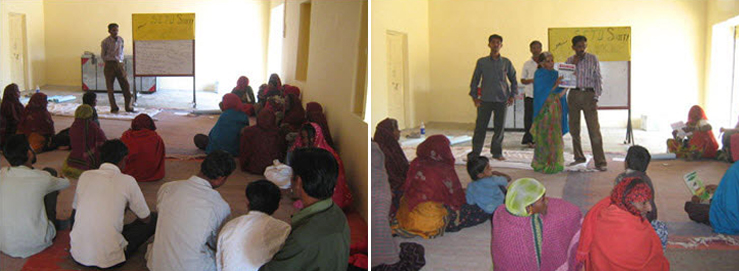Home / All Socio-economic Activities / “Health and nutrition workshop” at Barmer
Venue: Barmer, Rajasthan
(February 18, 2011)
An ill-fed child with his ribcage prominently on display, along with weak limbs and a pale dark skin is no eye candy but a reality for many of those who are suffering from Malnutrition, a nutritional disorder arising due to lack of balanced diet.
Malnutrition results from taking an unbalanced diet in which certain nutrients are lacking, in excess (too high an intake), or in the wrong proportions. A number of different nutrition disorders may arise, depending on which nutrients are under or overabundance in the diet. It is the gravest single threat to the world’s public health, says WHO.
A balanced diet consisting of all the essential nutrients acts as a precursor to be fit and fine and the only way to cure this health disorder. But sometimes, having access to proper nutrition is not always easy as it seems.
Here, we are talking about the poor people coming from the underprivileged and marginalized backgrounds who suffer from nutritional deficiencies mainly due to unaffordability of regular staples like wheat and grains. Another important factor contributing to malnutrition is lack of awareness on this issue. Therefore, making people aware about the right kind of food to eat can do wonders in this regard. As most of the time it happens that the diet contains only one type of nutrients in excess leading to incomplete nutrition. The basic need therefore is to educate people about the ill effects of this deadly condition and the changes to be done in the diet to make it a balanced one which is the only cure to it. To accomplish this a dedicated effort from the society is required. With this view, we recently organized a “Health and nutrition workshop” for our artisans of Barmer, Rajasthan throwing light on healthy food practices.
On 18th of February 2011, the workshop was organized at Barmer, Rajasthan. Artisans from Barmer and nearby villages registered their presence in huge numbers. SETU team member L.R. Kaushal started the session by first having a know how of the artisans eating habits. Upon interaction, it came to light that the artisans can’t afford to have wheat and pulses as staple food, in absence of which they have to totally depend on Bajra (pearl millet) as it is easily available and is also economical. This is a striking fact as bajra is not a regular staple and is consumed only in winters by most of the people. But here in Bramer, all the year round, the villagers feed solely on it, leading to incomplete nutrition in absence of other nutrients not being provided.
